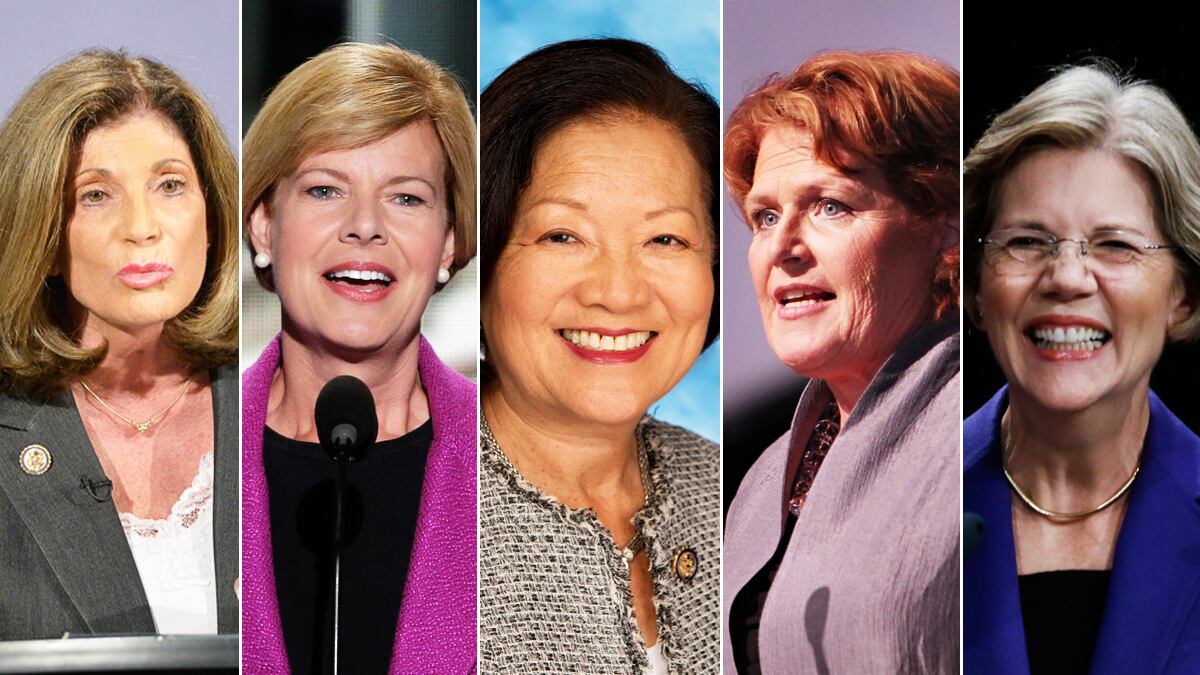Tammy, Shelley, Heidi, Mazie, and Elizabeth: a lineup of women that Democrats say is their best hope of keeping control of the U.S. Senate.
All are in competitive races, and with Republicans needing to pick up just four seats to take control, the balance of power could come down to these five: Tammy Baldwin in Wisconsin, Shelley Berkley in Nevada, Heidi Heitkamp in North Dakota, Mazie Hirono in Hawaii, and Elizabeth Warren in Massachusetts.

Six incumbent Democratic women senators are also up for reelection, including Claire McCaskill, whose fortunes improved dramatically after her opponent’s musings about “legitimate rape,” but who still faces a close race in Missouri. Nonpartisan political tracker Charlie Cook says there’s a very good chance we won’t know who’s in charge of the Senate when we wake up on the morning of Nov. 7, and that the likely outcome will be decided by a seat or two either way. He counts 11 toss-up races, with women the standard bearers in half of the high-profile contests.
Why the flood of estrogen? Democratic pollster Celinda Lake says it represents “a coming of age” with more women in the pipeline, together with what Democrats branded the “Republican war on women” that coincided with the Republican primaries earlier this year, and gave female candidates a lift.
Democrats are the biggest beneficiaries, but Republican Linda McMahon is doing better than anyone expected in Connecticut by focusing her efforts on wooing women and confronting claims that her party is anti-woman. In a recent television ad McMahon declares, “I am a woman, a pro-choice woman … an independent-minded woman.”
Her efforts have paid off. According to The New York Times, she has cut her gender gap down to just six points compared to the double-digit deficit many Republicans face this election season. McMahon still has an uphill climb in a blue state in a presidential year, but if she can appeal to women while holding the GOP’s traditional advantage among men, she may have found a winning formula.
“Women can’t believe the political system doesn’t get more done, and they think women will get down to business,” says Lake. “In the Connecticut race, [McMahon] is certainly communicating that she is focused on the right things.”
Women are making strides in maintaining their likability, says Lake, “a hard thing to do in tough campaigning, and Heidi is the poster child for that, Tammy too.”
Democrats all but wrote off North Dakota when incumbent Kent Conrad retired, but Heitkamp, the state’s former attorney general, has turned it into a real contest in part because of her winningly approachable style. Baldwin is surprising odds makers, who didn’t think an openly gay member of Congress could defeat Tommy Thompson, the popular three-term former governor.
“He should never have been a lobbyist if he wanted to come back,” says a GOP strategist who did not want to be quoted.
In the marquee race of Elizabeth Warren versus Scott Brown, Democrats jumped on Brown’s remark in a debate that his favorite Supreme Court justice is Antonin Scalia. Democrat Barbara Boxer called it “a breakthrough moment.” A Democratic consultant said it was a “big mistake” to cite “such a provocative right winger and one of the few justices people know. If he’d said [Justice Anthony] Kennedy, people would have said, ‘who’s that?’”
Warren has not run a good campaign, but according to Cook, Brown has to win “100 percent of Republicans, 100 percent of Independents, and one out of five Democrats. 200,000 Obama voters have got to switch over,” says Cook. “There’s a reason why Ed Brooke was the last Republican senator [from Massachusetts], and that was 30 years ago.”
There are currently 17 female senators, the most ever but nothing to brag about in a body of one hundred at a time when women are making bigger and bolder strides in virtually every other area of life.
With two Republican women retiring—Kay Bailey Hutchison of Texas and Olympia Snowe of Maine—the number drops to 15. Analyzing the field and doing the math, Debbie Walsh, who directs the Center for Women and Politics at the Eagleton Institute of Politics at Rutgers University, says that “if all the stars align in a certain way,” there could be 19 or even 20 women in the U.S. Senate after this election, “which is still very sad, that I’m excited about 19 in the Senate,” she said, “but after being stuck at 17 for so long,” she said (since 2009), 2013 could be the best year of the woman since the phrase was born in 1992.
Walsh’s math, which she says is conservative, counts a sure winner in Hawaii (two women are running against each other, Democrat Hirono, who is favored against Republican Linda Lingle). In Nebraska, Republican Deb Fischer is very likely to win; she’s leading Democrat Bob Kerrey, who is attempting a comeback after being away from the state and in New York for the last decade.
Walsh assumes that five of the six Democratic incumbents will win—all except McCaskill’s are considered safe holds. Of the two Democratic women challenging Republican incumbents—Warren and Berkely—Walsh assumes one will win, bringing her count to 18. And Walsh figures that either Baldwin in Wisconsin or Heitkamp in North Dakota will prevail, giving her a cautious count of 19.
But if the stars come together, the number could go up to 20—which would make one out of every five U.S. senators a woman, a milestone on the road to parity.





